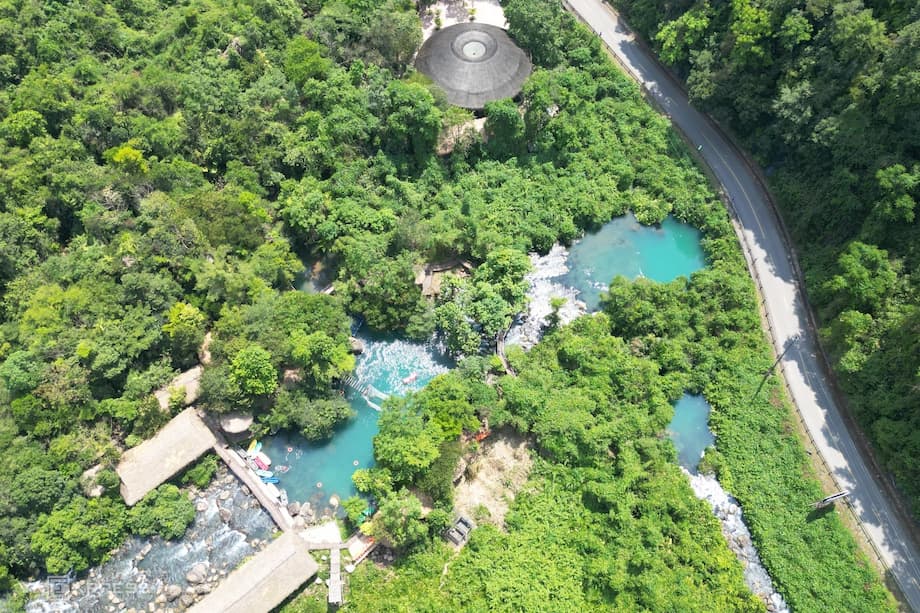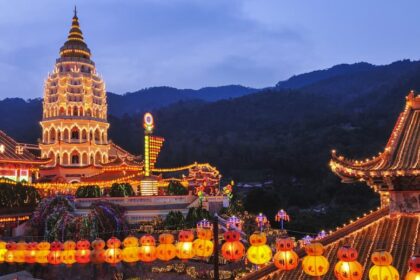Vietnam’s Phong Nha-Ke Bang National Park Welcomes Travelers to the Mystical Mooc Stream
Mooc Stream’s emerald waters, mysterious origins, and lush jungle setting make it a rising star for eco-tourism in central Vietnam.
Mooc Stream, nestled deep within the UNESCO-listed Phong Nha-Ke Bang National Park in central Vietnam, has become a magnet for travelers seeking adventure and tranquility. Located in Quang Binh province, about 500 kilometers south of Hanoi and 70 kilometers northwest of Dong Hoi city, this hidden waterway draws visitors with its striking blue-green waters, pristine forest surroundings, and the enduring mystery of its underground source.
- Vietnam’s Phong Nha-Ke Bang National Park Welcomes Travelers to the Mystical Mooc Stream
- What Makes Mooc Stream Unique?
- Travel Experience: Activities and Attractions
- Getting There and Practical Tips
- Environmental Challenges and Conservation Efforts
- Mooc Stream in the Context of Phong Nha-Ke Bang’s Natural Wonders
- Local Culture and Cuisine
- When to Visit and What to Expect
- What to Know
In recent years, Mooc Stream has transformed from a little-known spot along the western branch of the historic Ho Chi Minh Trail into a popular eco-tourism destination. Tourists from Vietnam and abroad now flock to its banks to swim, kayak, and explore the unique natural landscape, while local authorities work to balance visitor access with conservation efforts.
What Makes Mooc Stream Unique?
Mooc Stream stands out for several reasons. Its most captivating feature is the clarity and color of its water—a cool, emerald blue that reflects the dense jungle canopy and limestone cliffs surrounding it. The stream’s name, “Mooc,” comes from a local word meaning “to grow,” referencing the phenomenon of water columns rising from underground and merging with the Chay River. Despite multiple expeditions, including dives reaching depths of 70 meters, the true source of Mooc Stream remains undiscovered, adding to its allure.
The stream is located in the core zone of Phong Nha-Ke Bang National Park, a UNESCO World Heritage Site renowned for its extensive limestone karst landscapes, ancient caves, and rich biodiversity. The park itself is one of the world’s largest limestone regions, home to hundreds of caves—including the world-famous Son Doong Cave—and a vast array of plant and animal species, some of which are rare or endangered.
Surrounded by thick jungle, Mooc Stream offers a rare sense of seclusion and connection with nature. The area is especially vibrant from March to May, when wildflowers bloom and clouds of white butterflies fill the air, creating a magical atmosphere for visitors.
Travel Experience: Activities and Attractions
Mooc Stream is designed as an eco-tourism site, providing a range of outdoor activities that appeal to adventure seekers and families alike. Visitors can swim in the cool, clear water, kayak along the gentle current, or try their hand at fishing. For those who prefer to stay dry, a network of bamboo walkways and bridges winds through the forest, offering scenic views and opportunities for photography.
Stilt houses line the banks of the stream, providing shaded spots for dining and relaxation. Local restaurants serve rustic but delicious dishes such as grilled stream fish, chicken, boiled shrimp, and regional specialties like gac sticky rice and cactus soup. Hammocks strung beneath the forest canopy invite guests to unwind and soak in the peaceful surroundings.
Adventure games, rope swings, and guided tours are available for those looking to add excitement to their visit. The area is also a haven for nature lovers, with opportunities to spot orchids, birds, dragonflies, and other wildlife. During the butterfly season in April and May, the forest comes alive with color and movement.
Mooc Stream is often included in day trips alongside other attractions in Phong Nha-Ke Bang, such as the spectacular Phong Nha Cave, Paradise Cave, and the Chay River. The region’s caves are world-renowned for their size and beauty, with Son Doong Cave holding the title of the largest cave on Earth. These sites, together with Mooc Stream, create a diverse itinerary for travelers interested in both adventure and relaxation.
Getting There and Practical Tips
Reaching Mooc Stream is straightforward for most travelers. The nearest major city is Dong Hoi, which is accessible by train, bus, or airplane from Hanoi, Hue, or Danang. From Dong Hoi, visitors can rent a car or motorbike and follow the Ho Chi Minh Road to Phong Nha-Ke Bang National Park. The journey takes about 1.5 to 2 hours and passes through scenic countryside and forested hills.
Entrance fees to Mooc Stream vary by season. During the low season (January to March and October to December), adult package tickets cost around 110,000 VND (about $4.50 USD), while children’s tickets are 45,000 VND. In the peak summer months (April to September), prices rise to 180,000 VND for adults and 100,000 VND for children. General admission is also available at a lower rate, and children under 1.3 meters tall enter free. Facilities at the site include changing rooms, rest areas, and equipment rentals for water activities.
For accommodations, travelers can choose from homestays and guesthouses in Phong Nha town or hotels in Dong Hoi city. Chay Lap Farmstay and other eco-lodges offer a blend of rustic charm and modern amenities, along with activities like biking, gardening, and cooking classes.
Visitors are advised to bring sunscreen, mosquito repellent, sunglasses, and sturdy footwear. Respecting the environment and following local regulations is essential to preserve the area’s natural beauty for future generations.
Environmental Challenges and Conservation Efforts
While Mooc Stream’s popularity has brought economic benefits to the region, it has also raised concerns about environmental impact. The fragile ecosystem of Phong Nha-Ke Bang National Park is home to many rare species and unique geological formations, making conservation a top priority for park authorities.
Recent heavy rains in neighboring Laos have caused the waters of Mooc Stream and the Chay River to become temporarily murky, prompting local officials to warn visitors against swimming for safety reasons. Pham Hong Thai, director of Phong Nha-Ke Bang National Park, explained that the park’s management is committed to balancing tourism with environmental protection. He stated:
“Despite expeditions by cave experts to locate the source of Mooc Stream, it remains a mystery. We continue to monitor the site closely and advise visitors to follow safety guidelines, especially during periods of high water or poor visibility.”
Efforts to maintain the area’s ecological integrity include limiting visitor numbers during peak times, providing educational materials about local flora and fauna, and encouraging responsible tourism practices. The park’s tourism management center works with local communities to ensure that economic development does not come at the expense of the environment.
Mooc Stream in the Context of Phong Nha-Ke Bang’s Natural Wonders
Phong Nha-Ke Bang National Park is a treasure trove of natural attractions, with Mooc Stream serving as a gateway to the region’s broader wonders. The park’s limestone karst landscape, formed over millions of years, is dotted with caves, underground rivers, and towering cliffs. The area’s biodiversity is remarkable, with hundreds of plant and animal species, including some found nowhere else on Earth.
Nearby, the Chay River and Dark Cave (Hang Toi) offer additional adventure activities such as ziplining, mud bathing, and cave exploration. The park’s most famous cave, Son Doong, is so vast that it contains its own ecosystem, complete with jungle, river, and weather patterns. While access to Son Doong is limited to guided expeditions, other caves like Paradise Cave and Phong Nha Cave are open to the public and provide awe-inspiring experiences.
Mooc Stream complements these attractions by offering a more accessible and family-friendly option for enjoying the park’s natural beauty. Its tranquil setting and range of activities make it an ideal stop for travelers of all ages.
Local Culture and Cuisine
Visiting Mooc Stream is also an opportunity to experience the culture and hospitality of Quang Binh province. Local communities have embraced eco-tourism, offering homestays, guided tours, and traditional meals to visitors. The region’s cuisine reflects its riverine and forested environment, with dishes featuring fresh fish, shrimp, wild vegetables, and locally grown rice.
Popular menu items include:
- Grilled stream fish and chicken
- Boiled shrimp and wild vegetables
- Gac sticky rice (a vibrant orange rice dish)
- Banh loc (tapioca dumplings with shrimp and pork)
- Cactus soup and catfish salad
- Khai fish hotpot
Dining in stilt houses along the stream, guests can enjoy these flavors while listening to the sounds of the forest and water. The hospitality of local hosts adds to the sense of welcome and relaxation that defines the Mooc Stream experience.
When to Visit and What to Expect
The best time to visit Mooc Stream is from March to May, when the weather is cool and the landscape is alive with blooming flowers and butterflies. April is particularly beautiful, with the appearance of yellow Vang Anh flowers and swarms of white butterflies. June to August is also popular, though temperatures can be higher. The rainy season from September to November brings increased water levels and occasional flooding, while December to February is generally too cold for water activities.
During peak times, the site can become busy, so early morning or late afternoon visits are recommended for a quieter experience. The stream’s water temperature remains refreshingly cool year-round, rarely rising above 20 degrees Celsius, making it an ideal escape from the heat of central Vietnam’s summer.
What to Know
- Mooc Stream is located in the core zone of Phong Nha-Ke Bang National Park, Quang Binh province, Vietnam.
- The stream is famous for its clear blue water, lush jungle setting, and mysterious underground source.
- Activities include swimming, kayaking, rope swinging, nature walks, and enjoying local cuisine in stilt houses.
- The best time to visit is March to May for cool weather and butterfly season; avoid the rainy season for water activities.
- Entrance fees vary by season, with discounts for children and free entry for those under 1.3 meters tall.
- Recent heavy rains can affect water clarity and safety; check local advisories before swimming.
- Mooc Stream is easily combined with visits to Phong Nha Cave, Paradise Cave, and other park attractions.
- Travelers should bring sunscreen, insect repellent, and appropriate footwear, and respect local regulations to help preserve the environment.












